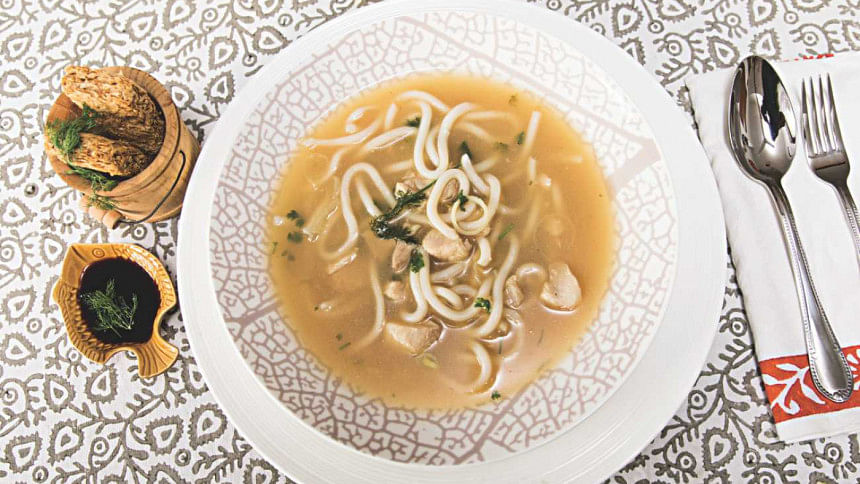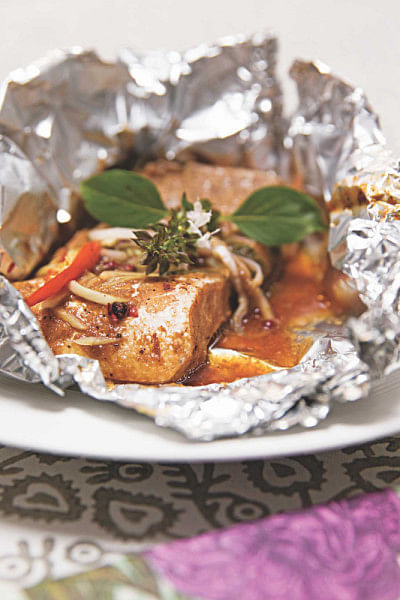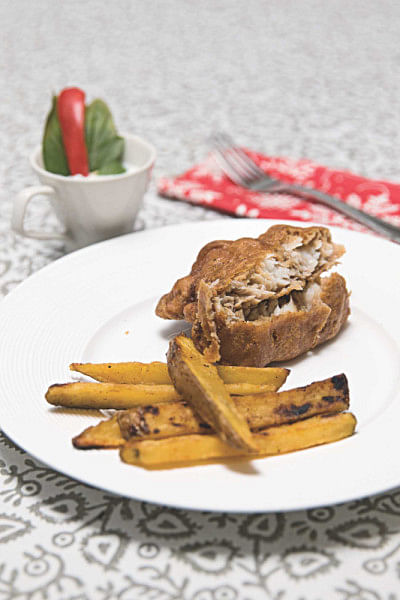Differently fishy

Fish recipes
Fish is consumed as food by many species, just like us! It is a great and important source of protein and other nutrients. Over 32000 species of fish have been described, making them the most diverse group of vertebrates. However, only a small fraction of that number is commonly eaten by us. Edible fish is categorised as either fin fish or shell fish. The term fin fish refers to the fishes that have a bony skeleton. Most fin fish come from salt water, however, lakes and inland water add considerable amounts to the total catch. Edible shell fish are mainly salt water fish. Shell fish is used to designate both mollusks and crustaceans.
Nutritional value
Fish provides a good source of high quality protein and a wide variety of vitamins and minerals, including vitamin A and D, phosphorus, magnesium, selenium, and iodine in marine fish. Its protein- like that of meat- is easily digestible and favourably complements dietary protein provided by cereals and legumes that are typically consumed in many developing countries. Fish is also the world's best source of omega-3 fatty acids, which are incredibly important for the body and brain.
Health benefits
Generally speaking, all types of fish are good for us. They are high in many nutrients that most people aren't getting enough of from other sources. Here are few health benefits of eating fish that are supported by research.
1. Fish may lower your risk of heart attacks and strokes
2. Fish may increase gray matter in the brain and protect it from age-related deterioration.
3. Fish may help prevent and treat depression, making you a happier person.
4. Fish is the only good dietary source of vitamin D.
5. Fish consumption is linked to reduced risk of autoimmune diseases, including Type 1 Diabetes.
6. Fish may help prevent asthma in children.
7. Fish may protect your vision in old age.
8. Fish may improve sleep quality.
Whether the fish is fresh can be checked by looking for the following qualities:
-The skin looks bright, moist and shiny. The scales should be firmly attached to the skin. The skin on stale fish may show signs of wrinkling and shrinking away from the flesh.
-The eyes of a freshly caught fish will be convex, the pupil will be black and the cornea translucent. The eyes should be bright, clear and bulging and not sunken.
-The gills of freshly caught fish are bright red, but as the blood in them oxidizes they rapidly turn brownish and any mucus on them turns opaque.
-If fish is split along the backbone and lifted, the bone should stick firmly to the flesh. If the bone separates easily, the fish is stale.
-The surface should be free of dirt and slime.
-The flesh should be firm to touch with no traces of browning or drying around the edges.
-A fish having odor indicates deterioration due to oxidation of polyunsaturated fat and bacterial growth. Rancidity is revealed by yellowish spots on the surface. Rancidity can be recognised by a sour taste, uncharacteristic of fresh fish.
Storage
It is estimated that 10-15 percent of fish is spoiled during catch and further handling. Fish spoils quickly and should be used as soon as possible. It should be kept covered in the coldest part of the refrigerator for no longer than 2 days. Pre-packed fish and shellfish can be refrigerated in the original package for a short time. Fish wrapped in butcher paper should be taken out and wrapped in aluminum foil or plastic wrap. Frozen fish maintains good quality when placed in the freezer immediately after purchase. Freezer temperatures of 0 degree F( -180 degree C) or lower are necessary to prevent loss of colour, texture, flavour and nutritive value. Cured fish is best kept covered in the refrigerator. Open canned fish should be used up immediately or refrigerated.

Fish Pie
Ingredients
500g white fish
600 ml milk
6-8 large potatoes
Pinch of salt
50g butter
1/2 tsp black pepper powder
1 1/2 tbsp plain flour
2 tbsp chopped parsley
100g grated cheese
Method
Preheat oven to 180 degree C. Place the fish in an oven-proof dish and cover with the milk. Bake in the oven uncovered for 30 minutes or till the fish is cooked through. Peel and chop the potatoes, and boil with a pinch of salt until soft. When the fish is done, drain the milk into a jug and keep aside. Flake the fish with a fork and leave in the dish. Once potatoes are done, drain, then add 30g of the butter and a splash of the reserved milk, and mash. In another saucepan melt the remaining butter on medium heat and slowly add flour, stirring constantly until you get a smooth paste. Add the remaining milk a little bit at a time, stirring constantly, until you get sauce-like consistency. Add the parsley and stir well. Cook for 5 minutes. Add the sauce to the flaked fish and mix well. Top of the mashed potato and spread evenly. Sprinkle the grated cheese and black pepper powder evenly over the potato topping. Place back in the oven for 30-40 minutes, or until the cheese is bubbling and slightly golden brown. Take out of the oven and leave to cool for 5 minutes and serve.
FISH AND CHIPS
Deep fried fish in a crispy batter with fat golden chips is still one of Britain and Ireland's favorite meal. First appearing in the 1860s, in 1910 there were more than 25,000 fish and chip shops across the UK, and by 1930s it increased to over 35,000.
Ingredients
500 gm boneless and skinless fish fillets
4 large potatoes, peeled and cut into strips
1 cup all-purpose flour
1 tsp baking powder
1 tsp salt
1 tsp ground black pepper
1 cup milk
1 egg
Oil for deep frying
Method
Place potatoes in a medium-sized bowl of cold water. In a separate medium sized mixing bowl, mix together flour, baking powder, salt, and pepper. Stir in the milk and egg and mix until a smooth batter forms. Let mixture stand for 20 minutes. Pre-heat the oil in a large pot or electric skillet to 350 degree F( 175 degree C). Fry the potatoes in the hot oil until they are tender. Drain them on paper towels. Dredge the fish in the batter, one piece at a time, and place them in the hot oil. Fry until the fish is golden brown. If necessary, increase the heat to maintain the 350 degrees F (175 degrees C) temperature. Drain well on paper towels. Fry the potatoes again for 1-2 minutes for added crispness. Serve hot with sauce.
Macher poulao (fish rice)
Ingredients
500 gm Rui fish, cleaned and cut into 6 pieces
2 cup aromatic rice, soaked in water for 30 minutes
1 bay leaf
1 tsp ginger paste
1 tsp red chilli paste
3/4 cup thinly sliced onion
4 pods of garlic, finely chopped
1/2 tsp turmeric powder
1/2 tsp garam masala powder
4-5 tsp ghee
Salt to taste
Cashew-nuts, raisins as required
4 cups warm water
Oil for deep frying
Method
Wash rice and soak it in water for 30 minutes. Let the water drain. Marinate fish with salt and turmeric powder for 15 minutes. Deep fry fish pieces and keep aside. Heat 2 tablespoons of ghee in a deep pan. Add chopped onion and sliced onion and fry till golden brown. Add bay leaf, chilli paste and 1/4 tsp garam masala powder, sauté for 2 minutes on medium low heat. Mix fried fish pieces into thus spice mixture and fry for another 2 minutes, remove from pan and set aside. Add remaining ghee in the same pan. Add rice, garam masala powder, turmeric powder, cashew-nuts, raisins, and salt in it. Fry for 2 minutes. Add warm water and mix well. Higher the flame till it starts to boil. Cover with a lid and place on the stove to let simmer exactly for 15 minutes. Switch off the heat now. Arrange fried fish pieces with onion mixture on the top. Cover it for another 10 minutes. Serve hot with any curry or raita.

Spring Shrimp Rolls
Ingredients
20 pieces large shrimp, peeled and deveined with tail left on
1 package spring roll wrappers (20 count)
1 cup sweet and sour sauce for marinade and dipping
Salt and pepper to taste
Oil for frying
Method
Cut 10 spring roll sheets in half diagonally so you end up with 20 triangles. Keep them in their container until ready for use. Pat dry the shrimp. Using a knife, make a few nicks on the inside of the shrimp. This will help them to lay straight when you roll. Slightly add salt and pepper then lightly brush both sides of the shrimp in the sweet and sour sauce and let them sit for 10 minutes. Lay the shrimp with the tail towards you on the spring roll triangle. Cover the shrimp with the right corner and roll tightly to the centre, fold down the top corner and continue to roll. Dip your finger in water and lightly wet the third corner to seal the roll. Keep finished shrimp under a damp towel to keep from drying out, or put them in oil right away. Heat oil in a pan on medium high. Once the oil is hot, place the shrimp in, a couple at a time. Fry until golden brown. Serve with sweet and sour sauce for dipping.
Fish and noodle soup
Ingredients
3 cups fish stock
400g korla fish, cut into small pieces
200g noodles
100gm baby spinach
2 tsp soy sauce
2 celery sticks, thinly sliced
200g mushrooms, sliced
1 tbsp freak grated ginger
1 clove garlic, grate
Salt and black pepper powder to taste
Method
Place stock, water and soy sauce in a large pan. Bring to boil over medium heat. Add celery, mushrooms, ginger, garlic and noodles. Simmer, partially covered for five minutes, add fish and simmer for 3-4 minutes or until fish is just cooked through. Add spinach and cook, stirring until leaves are wilted. Season with salt and pepper. Serve hot.
Photo: Sazzad Ibne Sayed
Food styling: LS Desk

 For all latest news, follow The Daily Star's Google News channel.
For all latest news, follow The Daily Star's Google News channel. 



Comments